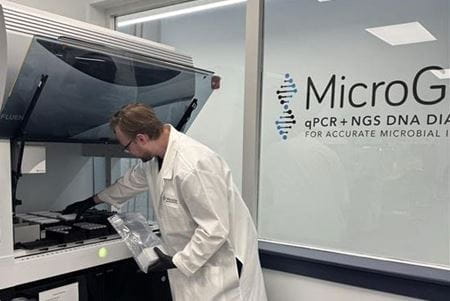INDIANAPOLIS — Indiana University School of Medicine researchers are leading a multicenter, multidisciplinary clinical trial to study how rapid DNA sequencing technology can help improve treatment for fracture-related infections, a serious health complication that can occur after broken bone surgery.
While orthopedic trauma research and care have improved over the years, the treatment of fracture-related infections fails in approximately 30% of patients, according to a 2025 study published in JAMA Surgery.
Fracture-related infections may develop at various points of treatment, so a care team must mitigate that possibility at every stage. Surgical site infections are often responsible for prolonged recovery, long-term health issues, failed bone healing, permanent disability, amputation and additional surgeries, with an estimated annual cost of $3 billion in the United States, according to a 2022 study published in Archives of Bone and Joint Surgery.
Lower-extremity fractures are particularly prevalent among military service personnel and can greatly impact military lost duty time, readiness and the overall health of personnel, according to a 2017 study by the U.S. Military Health System, which reported a $116 million expense — $24 million in direct medical costs and nearly $92 million ($900,000 lost duty and $91 million limited duty) in indirect medical costs.
Bringing next-generation biomedical technology to patients
The IU School of Medicine-led research team will evaluate whether integrating next-generation sequencing — a modern technology that enables the rapid sequencing of millions of DNA or RNA fragments to identify bacteria and fungi — into patient care could help reduce treatment failure rates and recurrent infection among people with fracture-related infections.
IU Health Methodist Hospital and Eskenazi Health have joined 13 other clinical sites to run the clinical trial through the Major Extremity Trauma Research Consortium, which brings together more than 80 trauma centers across the United States and Canada to advance care standards for patients with severe extremity trauma. Researchers plan to enroll 250 patients between the ages of 18 and 84, whose treatment will be monitored for one year. The four-year study is currently open and is supported by a $2.5 million grant from the U.S. Department of Defense.

Roman Natoli.
"We hope to get more information from the next-generation sequencing diagnostics that will uncover pathogens that would have not been identified by our current standard tools," said Roman M. Natoli, MD, PhD, associate professor of orthopedic surgery in the Department of Orthopaedic Surgery at IU School of Medicine and principal investigator of the clinical trial. "This trial will allow us to choose more appropriate antibiotic treatment via next-generation sequencing results and ultimately, if we're correct, reduce the rate of failure for treating patients that have infections after fractures. We hope to not only reduce the failure rate in fracture-related infections but also bring wounded warriors and civilians to more optimal function, where they can return to active duty, work and life."
If the clinical trial succeeds in improving patient outcomes, it could lead to more effective treatments resulting in reduced re-hospitalizations, fewer surgeries and amputations, more survivors and billions of dollars saved in health care delivery.
"Microbiologic methods of diagnosing fracture-related infections have been largely unchanged for decades," said Gregory Schrank, MD, a co-investigator on the trial and an assistant professor of medicine and infectious disease specialist at the University of Maryland School of Medicine. "Next-generation sequencing represents a potential leap forward in our ability to more accurately diagnose the organisms causing these highly morbid infections. Better targeted antibiotic treatment guided by next-generation sequencing will hopefully improve the rate of clinical cure for patients with fracture related infections and keep them on the road to recovery."
Collaborating with industry and clinical partners to enhance expertise
MicroGenDX, an industry partner on the study, is providing the next-generation sequencing testing for participating sites. The MicroGenDX laboratory is accredited by both the College of American Pathologists and is a Clinical Laboratory Improvement Amendments-certified laboratory.
"What we are doing is sequencing a marker gene that kind of acts as a bar code for all the bacteria and fungi that we know exist," said Craig Tipton, PhD, director of biostatistics at MicroGenDX. "We can selectively identify this one target, quantify it, get an idea of how much is there — and match it against a reference database to learn what is causing the infection."

Industry partner MicroGenDX provides advanced DNA diagnostics. | Photo courtesy of MicroGenDX
Tipton said the current standard of care for treating fracture-related infections uses polymerase chain reaction (PCR) and culture tests, which are limited in the types of organisms they can identify, whereas next-generation sequencing reads the microbial DNA present and identifies bacteria comprehensively. The researchers anticipate next-generation sequencing will provide more information to help clinicians decide what the best course of action is for individual patients.
"Knowing exactly what is causing your infection through microbial DNA removes guess work out of the equation and enables more personalized treatment when deciding what antibiotics are best for you," Tipton said.
Hospital-based infectious disease specialists collaborating on the clinical trial will ensure the antibiotics used target the specific bacteria found for each patient by next generation sequencing and will monitor patients per normal standard of care.
Evan D. Robinson, MD, an assistant professor of clinical medicine at the IU School of Medicine and an infectious disease specialist at IU Health, who is among the study's collaborators, said infectious disease specialists constantly weigh the benefits and risks of any antimicrobial treatment because of the potential for negative outcomes.
"With better diagnostics, we're able to be more precise in our antibiotic treatment — and possibly reduce side effects and the risk of antibiotic resistance," Robinson said. "Getting treatment right the first time may also reduce the amount of antibiotics to which a patient is exposed."
Additional clinical sites based on projected enrollment include R Adams Cowley Shock Trauma Center at the University of Maryland in Baltimore, Maryland; Vanderbilt University Medical Center in Nashville, Tennessee; Atrium Health in Charlotte, North Carolina; Dartmouth-Hitchcock Medical Center in Lebanon, New Hampshire; Hennepin County Medical Center in Minneapolis, Minnesota; Inova Fairfax Medical Campus in Falls Church, Virginia; Metro Health in Cleveland, Ohio; UTHealth Houston in Houston, Texas; UW Health in Madison, Wisconsin; UCSF Health in San Francisco, California; University of Utah Hospital in Salt Lake City, Utah; and Loyola University Medical Center in Maywood, Illinois.
"This clinical trial would not be possible without a truly collaborative physician-driven consortium that brings together multidisciplinary expertise from top trauma centers across the country," Natoli said. "Through our coordination with METRC, we can provide more patients access to the latest orthopedic trauma therapies that may become the next standard of care."
About the Indiana University School of Medicine
The IU School of Medicine is the largest medical school in the U.S. and is annually ranked among the top medical schools in the nation by U.S. News & World Report. The school offers high-quality medical education, access to leading medical research and rich campus life in nine Indiana cities, including rural and urban locations consistently recognized for livability. According to the Blue Ridge Institute for Medical Research, the IU School of Medicine ranks No. 13 in 2024 National Institutes of Health funding among all public medical schools in the country.
Writer: Angie Antonopoulos, eantonop@iu.edu
For more news, visit the IU School of Medicine Newsroom: medicine.iu.edu/news




